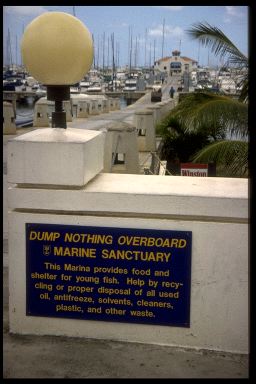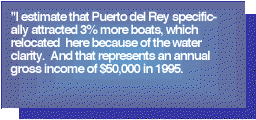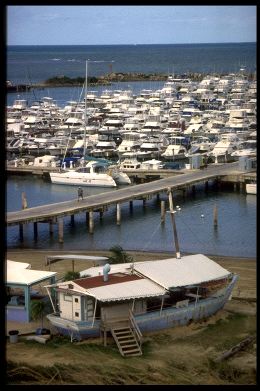
20. Puerto Del Rey Marina
Clean Water Attracts Customers Environmental change
| Location: | State Road #3, Km 51.4, P.O. Box 1186, Fajardo, Puerto Rico 00738 |
| Telephone: | (809) 860-1000; fax: (809) 860-7592 |
| Interviewed: | Daniel Shelley, President |
| Owned by: | Daniel Shelley, Puerto del Rey, Inc. |
| Waterbody: | Atlantic Ocean/Caribbean Sea |
Environmental change
Improved water circulation resulted after this Caribbean island marina opened a breachway in its solid breakwater.
The world class marina
"Puerto del Rey" means "king's port" in Spanish and demonstrates owner and developer Daniel Shelley's plan to build a marina with strong linkage to Puerto Rico's colonial heritage. Now the Caribbean's newest, largest full-service marina, Puerto Del Rey is a major boating gateway to the Virgin Islands and the Lesser Antilles. Completed in 1988, this "king's port" in 1995 was operating at near its capacity of 700 slips on concrete fixed piers and 450 covered dry racks for smaller boats three-high, with extra spaces along piers and at anchor for transient boats.
On an ocean-exposed beach pounded by storm waves from the east, Shelley first constructed an offshore graded stone rubble mound, 1,600 feet long. With 3-ton armor stones, the solid breakwater sits in water 20 feet deep and rises to 11 feet above mean high water at its top. The breakwater runs north to south, parallel to the beach, and was originally connected to the land with another 1,600-foot stone rubble mound jetty-in a shape somewhat like the letter L-which also protected the southeast exposure. The structures met their first major test when Hurricane Hugo's eye passed directly over a half-full Puerto del Rey in 1989. Hugo extensively damaged other marinas on eastern Puerto Rico before moving on to damage the U.S. mainland. However, Shelley's massive breakwater and reinforced concrete piers successfully survived with no structural damage, only 5% of the boats sunk, and moderate damage to others-a testament to Shelley's insistence on major protection and the design of Moffatt & Nichol Engineers.
About 80% of Puerto del Rey's customers are Puerto Rican residents who make the marina their home port. It is also a destination marina and a stop-off for transients from other ports and countries. Open year-round, the marina's busiest boating season is from October through April. Only 30 of the 1,150 boats are used as liveaboard residences. Boats range in size from 30 feet up to 150-foot yachts.
In addition to slips and rack storage, Puerto del Rey Marina offers a wide and unique mix of other services-unusual in the Caribbean. For boat care, there is a full-service boatyard that moves boats with a combination of a 60-ton hydraulic trailer, a 77-ton travel lift, and three marina forklift trucks. Maintenance services include painting and repairs to hulls, fiberglass, and engines. A fuel dock with pumpout is available at the harbormaster's pier, near the marina's south entrance, which also houses the U.S. Customs Service Office. One separate section of the marina is available for commercial fishing boat use and a ferry to St. Thomas. The Puerto Rico Department of Natural Resources (DNR) is using a building for its Regional Fisheries Office and has its own dock for its small research vessels. There are no other marinas within a radius of 2 miles, and there is a combined fleet of nearly 2,000 recreational boats in the Fajardo area.
For boaters' comfort, extra-wide fixed (nonfloating) piers accommodate a large number of people walking and motorized carts driven by marina staff who ferry people to and from parking lots to their boat slips as far 1,200 feet seaward. Excellent restrooms and showers are available to all boaters and guests, as are a laundry, four restaurants, vending machines, a used boat brokerage, a ship's store, a car rental agency, an open air plaza, a children's playground, a heliport, and condo apartments with some available for rent. The Puerto del Rey Yacht Club helps to organize boating events and educational programs.
"First-class" is inadequate to describe this marina, which is more "world-class" in its design, construction, amenities, services, and management. But this is just the beginning of a much larger full-service resort and coastal land development project planned. Interestingly, Shelley decided to build the marina first as the cornerstone to the rest of the project. Just as the first Spanish settlers always built settlements at the harbor, so here establishing the port was of primary importance.
 |
"Dump nothing overboard-- marina sanctuary" sign, posted in Spanish and English. |
Management measures
Puerto del Rey Marina complies with the marina management measure for marina flushing, as well as the measures for water quality assessment, shoreline stabilization, storm water runoff control, fueling station design, sewage facility, maintenance of sewage facilities, solid waste, liquid materials, petroleum control, boat cleaning, and public education.
Cost/benefits
Removal of a 200-foot section of the 1,600-foot stone rubble mound jetty cost $30,000. The new breachway offers a south exit from/entrance to the marina and provides better flushing for the waters enclosed by the breakwater. In 1995 an estimated 3% more boats came to Puerto del Rey Marina because of its superior water clarity, resulting in an additional annual gross income of $50,000.
Environmental improvements
Puerto del Rey Marina removed 200 feet from the outermost end of its 1,600-foot
stone rubble mound jetty connection to the offshore breakwater. It cost $30,000 for
a dragline crane and labor to remove the stone and gravel down 20 feet to the original
seabed. The material was placed on the breakwater for extra thickness and protection. The breachway was opened
for two reasons: to give boats a more protected south entrance when the wind waves
were coming from the northeast, and to allow better water circulation. "I was
afraid that without the opening, the marina basin would have the same cloudy appearance
as most of the other marinas around us," said Shelley. "I want the cleanest,
safest marina anywhere."
breakwater for extra thickness and protection. The breachway was opened
for two reasons: to give boats a more protected south entrance when the wind waves
were coming from the northeast, and to allow better water circulation. "I was
afraid that without the opening, the marina basin would have the same cloudy appearance
as most of the other marinas around us," said Shelley. "I want the cleanest,
safest marina anywhere."
Once the opening was made and the docks began to fill, "People visited from
other marinas and liked our clean water. I estimate that Puerto del Rey specifically
attracted 3% more boats, which relocated here because of the water clarity. And that
represents an annual gross income of $50,000 in 1995." If the cost of making
the opening in the breakwater is amortized over 20 years at a 5% interest rate, its
annual write-off cost would be $2,400, which reduces the net return to $47,600. "Not
too bad!" said a smiling Dan Shelley.
| Openings in the far corner of the 1,600 foot long solid rock breakwater gives excellent hurricane protection and allows improved water circulation and boating access. |  |
Other benefits
Most of the natural sloping sandy beach was left undeveloped to retain much of the original shoreline and to help dissipate any waves that might enter the marina or be caused by boat wake. One unanticipated environmental advantage is that floating trash and seaweed, instead of accumulating in slips or in the boatyard, wash onto the beach at the high tide line and can be easily cleaned up by marina staff.
The Puerto Rico DNR Fisheries Office, in cooperation with the marina, rescues injured sea turtles, which has also become a popular event for the boaters and public.
Signs, in English and Spanish, explain the importance of keeping the marina clean. Some of the sign language came directly from a spring 1995 Marine Environmental Management Workshop-one of a nationwide educational series sponsored by the International Marina Institute.
"Puerto del Rey will have the only working pumpout in the entire Caribbean Sea," claimed Shelley. "We have been approved for a Clean Vessel Act pumpout grant to expand our existing boat sewage handling capabilities as a demonstration project for other marina owners in Puerto Rico." He hopes to have the pumpout completed for the 1995-96 peak "winter" boating season. Pumpouts will be free.
The boatyard will be moved inland about 1,000 yards onto a vacant industrial yard, possibly during 1996. This move will reduce the chance of boat repair pollutants from reaching the sea to almost zero. And it will free the waterfront for other, cleaner boating services and amenities. The now full dry storage racks will also be expanded, to double their capacity, allowing more small boats to use the marina without the need for annual bottom painting.
http://www.epa.gov/owow/NPS/marinas/ch20.html
This page last updated October 4, 1999


